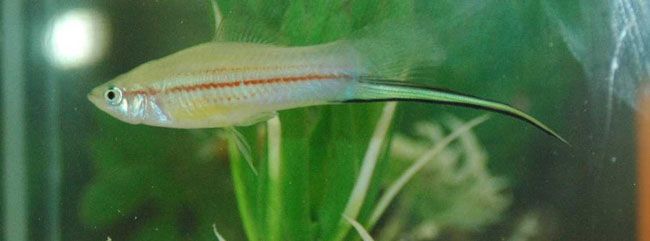How Female Fish Lose Inhibitions

In the fishbowl version of a pickup joint, the mere sight of a well-endowed male swordtail causes genes to switch off in the female's brain. The result: She throws caution to the wind to win the hunky mate.
Female swordtails are attracted to large males adorned with body ornaments, such as long tails and striking coloration.
In a series of fish-tank experiments, researchers showed that when a swell swordtail catch is around, certain of the female genes linked with sexual behaviors were in a sense modified. The gene changes occurred in just 30 minutes, quick enough so the preferred male could bait the female with body ornaments and size before reeling her in.
The phenomenon, detailed in the Dec. 4 online version of the journal Proceedings of the Royal Society of London B, suggests a suite of genes that under normal circumstances keep female swordtails from mating can be switched off when preferred males are nearby.
"When females were most excited—when attractive males were around—we observed the greatest down regulation [turning off] of genes," said Molly Cummings of the University of Texas at Austin. "It's possible that this could lead to a release of inhibition, a transition to being receptive to mating."
Fish lures
Cummings and UT colleague Hans Hofmann placed individual female swordtails into the centers of tanks for 30 minutes, with each tank separated into three connected zones. The females were accompanied by one of the following: a pair with one attractive male and one unattractive male; unattractive males; other females; or no fish.
Sign up for the Live Science daily newsletter now
Get the world’s most fascinating discoveries delivered straight to your inbox.
Meanwhile, the researchers extracted so-called messenger RNA (mRNA) from the females to determine which genes were being "turned on" and "turned off."
A gene is a set of biological instructions, so turning off a gene prevents instructions from being carried out. Switched on, the gene's DNA turns into mRNA, which ultimately gives rise to the mighty protein. And it's proteins that carry out the processes and activities of living things.
Turned off?
In the presence of both an attractive male and unattractive one, females would slowly swim away from the attractive males and then quickly turn around to face their mates. This gliding behavior typically precedes copulation in swordtails.
Genetic analyses showed that 77 genes out of the 3,000 analyzed were involved in females' mate-choice behaviors. Ten percent, or about 300 genes, could change their activity depending on mating conditions.
While some genes were turned on when females found a male attractive, a larger number of genes were turned off, they say. The same genes that turned off when females were with attractive males turned on when they were with other females or the puny males, and vice versa.
The off or "down-regulated" genes could play a role in inhibiting sexual behaviors, the authors speculate. So when the genes shut down or decrease their activity, they release the chastity belt, allowing females to pursue and mate with the dazzling dudes.
"In the presence of the attractive male, [these genes] are inactivated and as a consequence this inhibition goes away," Hofmann told LiveScience.
He added, "The genome is very dynamic and changes in genome expression occur all the time as we get exposed to new environmental situations, in this case social situations, continuously."
- Animal Sex: No Stinking Rules
- 10 Amazing Things You Didn't Know About Animals
- Image Gallery: Freaky Fish
Jeanna Bryner is managing editor of Scientific American. Previously she was editor in chief of Live Science and, prior to that, an editor at Scholastic's Science World magazine. Bryner has an English degree from Salisbury University, a master's degree in biogeochemistry and environmental sciences from the University of Maryland and a graduate science journalism degree from New York University. She has worked as a biologist in Florida, where she monitored wetlands and did field surveys for endangered species, including the gorgeous Florida Scrub Jay. She also received an ocean sciences journalism fellowship from the Woods Hole Oceanographic Institution. She is a firm believer that science is for everyone and that just about everything can be viewed through the lens of science.













